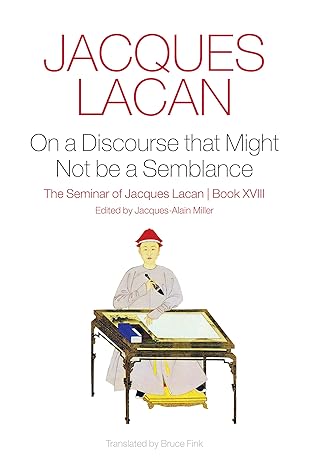On a Discourse that Might not Be a Semblance: The Seminar of Jacques Lacan, Book XVIII

Book Details
- Publisher : Polity Press
- Published : October 2024
- Cover : Hardback
- Pages : 210
- Category :
Lacanian Psychoanalysis - Catalogue No : 97940
- ISBN 13 : 9781509510108
- ISBN 10 : 1509510109
Also by Bruce Fink
A Clinical Introduction to Lacanian Psychoanalysis
Price £30.95
Also by Jacques Lacan
The Seminar of Jacques Lacan IX: Identification
Price £22.50
Also by Jacques-Alain Miller
There are currently no reviews
Be the first to review
The title is, at first glance, enigmatic. Clue: it concerns men and women—their most concrete, amorous, and sexual relations in everyday life, as well as in their dreams and fantasies. It has nothing to do with what biology studies under the heading of sexuality, of course. Must we leave this field to poetry, novels, and ideologies? Lacan attempts to provide a logic for it here—one that is quite cunning.
In the sexual realm, it is not enough to be; one must also exhibit. That is true of animals. Ethology has detailed the display behavior that precedes and conditions mating: it is, as a rule, the male who signals his intentions to a potential partner by exhibiting shapes, colors, and postures. These imaginary signifiers constitute what we call semblance. Similar exhibitions have been noted in human beings, and have served as grist for satire. In order to serve as grist for science, we must clearly distinguish them from the real that they veil and manifest at the same time—that of jouissance.
The latter is not the same for both sexes. Difficult to locate in women—and in fact, diffuse and unsituable—the real at stake for men is coordinated with a major semblance: the phallus. The upshot being that, as opposed to what commonsense would have us believe, men are slaves of the semblance they prop up, whereas, women are freer in this regard, and are also closer to the real; and that if a man is to sexually encounter a woman, he must put semblance to the test of the real, which is tantamount for him to the “moment of truth”; and that, if the phallus is suitable for signifying man as such—“every man”—feminine jouissance, because it is “not wholly” taken up in semblance, constitutes an objection to the universal.
A logic is, therefore, possible, if one has the audacity to write the phallic function as follows, F(x), and to formalize the two distinct ways in which a subject can be sexualized by inscribing himself in that function as a variable. This approach requires us to go beyond the myths invented by Freud, those of the Oedipus complex and of the father of the primal horde (Totem and Taboo); to mobilize Aristotle, Peirce, and the theory of quantification; and to elucidate the true nature of writing, including both Chinese and Japanese.
At the end of this trajectory, the reader will know how to elucidate Lacan’s aphorism, “There’s no such thing as a sexual relationship.”
Jacques-Alain Miller
Table of Contents
Translator’s Note
Figures and Illustrations
1. Introducing the Title of the Seminar
2. Man and Woman
3. Against the Linguists
4. Writing/The Written and Truth
5. Writing/The Written and Speech
6. On a Function that is not to be Written
7. Class on “Lituraterre”
8. Man and Woman and Logic
9. A Man and a Woman and Psychoanalysis
10. On the Myth that Freud Forged/Invented
Appendix
A number of references that Lacan makes to his own work, and to that of others (by Jacques-Alain Miller)
Index
About the Author(s)
Jacques Lacan (1901-1981) came to psychoanalysis by way of medicine and psychiatry. In 1951 he turned his attention to the training of analysts, and this was one of the issues which led him and his circle to part company with the Société Psychanalytique de Paris. He became, in 1953, the first President of a new group, the Société Française de Psychanalyse, whose declared aim was a return to the true teaching of Freud. Eleven years later the Société Française was dissolved and, under Lacan's direction, gave birth to the École Freudienne de Paris. Jacques Lacan was a practising psychoanalyst and teacher up until his death in 1981.
Jacques-Alain Miller is Director of the Department of Psychoanalysis at the University of Paris VIII and editor of Lacan’s Seminars.
More titles by Jacques-Alain Miller
Bruce Fink is a Lacanian psychoanalyst and supervisor who trained in France with the psychoanalytic institute Jacques Lacan created shortly before his death, the Ecole de la Cause Freudienne in Paris. He has translated several of Lacan's works into English - including Ecrits, The Names-of-the-Father, The Triumph of Religion, and Seminars VI, VIII, XVI, and XX - and is the author of numerous books on Lacan, including The Lacanian Subject, A Clinical Introduction to Lacanian Psychoanalysis, Lacan to the Letter, Fundamentals of Psychoanalytic Technique, Against Understanding (2 volumes), and Lacan on Love. More recently, he published A Clinical Introduction to Freud: Techniques for Everyday Practice. A board member of the Pittsburgh Psychoanalytic Center, he has also penned several mysteries involving a character loosely based on Jacques Lacan: The Psychoanalytic Adventures of Inspector Canal, Death by Analysis, Odor di Murderer/Scent of a Killer, The Purloined Love, and most recently The Da Vinci Staircase: Love and Turbulence in the Loire Valley. His books have been translated into over a dozen languages.
Customer Reviews
Our customers have not yet reviewed this title. Be the first add your own review for this title.









